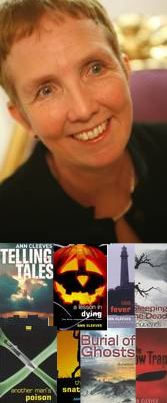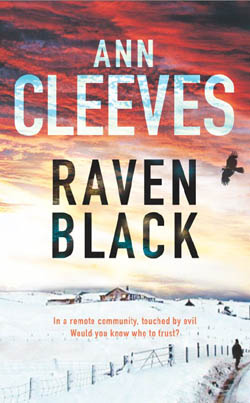



 
|
|

|

|
|
With
Raven
Black How did it feel to win the first ever Duncan Lawrie Award? And apart from the prize money, has it made a material difference to you - for example, raising your profile or introducing you to a new audience? It was unbelievable. The shortlist was so strong I didn't think I stood a chance - and I thought they'd let the winner have a hint in advance. I'm not the sort of person who wins things. The prize money is lovely. It buys me time to write. Most of us don't make enough from our writing to live. Since winning the award I've sold the translation rights to European and Scandinavian countries where I've never been published before - and to Japan and Korea. And I see my books in shops now. You have lived on two islands: Fair Isle and Hilbre in the Dee Estuary. This must have given you a strong sense of island life. What attracted you to the idea of setting Raven Black on an island: the idea of a closed community, perhaps? Or the fact that Catherine Ross, being English, is an outsider? And in which ways did an island setting affect the way you conceived the storyline? I didn't set out to set a book on an island. In fact, I was in the middle of a Vera Stanhope novel, when I went to Shetland between Christmas and New Year. It had snowed, then frozen on top of the snow, one of those clear frosty days. We saw three ravens, very black against the snow. I thought: If there were blood as well, it would be like a fairy story. That image stuck with me. I thought it might make a short story, but it turned into a novel. I left the book I was writing and Raven Black took over. But I do like writing about enclosed communities. I think I'm a traditional detective story writer at heart. The theme of outsiders and insiders runs through the book. Catherine Ross is obviously an outsider. But so, in a way, is Magnus Tait. And Jimmy Perez. I'm not sure about how the setting affects the storyline. Perhaps the book could be set in any community where it's hard to keep secrets. Characters grow out of place though. Shetland is different from anywhere else in the UK. It's isolated, but oil brought a lot of money very quickly. One of the pleasures of reading Raven Black is learning about the Shetland Isles, for example the Viking fire festival of Up Helly Aa, which provides a significant backdrop to the story. Are all the factoids you introduce true, or are parts fictionalised? I tried to get as many details right as I could. Up Helly Aa is a wonderful spectacle - though I'd never actually seen it before writing the book. I did go this year - we launched Raven Black in Lerwick at the beginning of February. It was a bit nerve-wracking watching the parade. I was worried that it would be nothing like the description in the book. In fact, I was pretty close. You've said that you intend Raven Black to be the first in a 'Shetland Quartet'. Will the other three novels star Inspector Jimmy Perez? And how did this character evolve - in particular, what drew you to giving him a Spanish ancestry? Yes, Jimmy Perez will appear in the other books, though perhaps in one the story won't be told from his point of view. Each book will be set in a different season. I'm working on a mid-Summer novel. I can't remember how I decided to give him the exotic background. You'll have gathered that I don't really plan anything about the books in advance. It seemed to fit in with the theme. An Armada ship called The Gran Grifon was wrecked off Fair Isle. There's a hint of a strong love interest for Perez in Fran, the islander who discovers the body of murdered schoolgirl Catherine and another girl murdered several years earlier. But tantalisingly you give Perez a strong motivation to move back to Fair Isle. Have you thought yet of how these aspects of Perez's life will pan out in the next instalment? Well, Jimmy is still in Lerwick for the next novel. As for the love interest, you'll have to read the next book… Do you particularly identify with any characters from Raven Black and, if so, why? I identify with all my characters when I write them, even, or perhaps especially, the less attractive ones. Writing's a bit like acting, I think. You have to believe you're the person you're writing, stand in their shoes and get inside their head. Birds seem to be a theme of your novels: Ravens have a symbolic significance in Raven Black; George and Molly Palmer-Jones from your first series are bird-watchers; you yourself worked at a bird observatory on Fair Isle and your husband is a warden for the RSBP. Similarly, isolated communities seem to be a recurring theme in your novels. What draws you to these themes? It's about writing what you know. As you say, Tim, my husband has worked in conservation for all his career. I can't imagine living in a city and would find it hard to write a novel set there. In the UK there's an idea that rural crime is always cosy. I'm not sure that has to be true. Shetland is bleak and hard. From A Bird in the Hand (1986) until
The
Baby Snatcher I've only written two standalones:
The
Sleeping and the Dead Both The Crow Trap and Raven Black were going to
be standalones. I liked Vera Stanhope so much that I brought her back,
first in
Telling
Tales I didn't think it would be credible to have a series set in Shetland. How likely would it be to have lots of murders in such a small community? And wouldn't all the books seem the same? But the demand came first from my German publisher. Then I came up with the idea of a quartet with each book set at a different time of the year. The changes in season are very dramatic that far north. It's like writing about a different place. Can you tell us a little about the story of Hidden Depths and how it evolved? And when's it due to be published? Hidden Depths is back in the Northumberland which I love. There are two murders, each body is found in water, covered with flowers. Almost like a piece of art. There seem to be no other links between the victims. It's more elaborately plotted than most of my books. Again I'm not quite sure where it came from. The stunning visual image, perhaps. The book will come out in February. |

| Webmaster: Tony 'Grog' Roberts [Contact] |